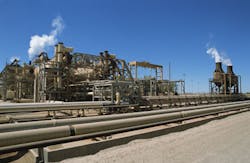W.Va. pipeline operator issued corrective action order following explosion
The U.S. Pipeline and Hazardous Materials Safety Administration has ordered a number of corrective actions that Columbia Gas Transmission will have to implement before it is allowed to resume operation at its natural gas pipeline near Sissonville, W.Va., where there was a big explosion on Dec. 11, according to the Republic.
The regulator found that bringing the pipeline back into use in its current state would be a threat to people, property and the environment. The watchdog claimed that the pipeline operator would have to follow the corrective steps it had been issued. According to Damon Hill, a spokesman for the Pipeline and Hazardous Materials Safety Administration, issuing the order was necessary to make sure the pipeline can resume operation as safely as possible and confirm that the integrity of the pipeline is sound. Columbia Gas is expected to submit an action plan for restarting operations, giving details about how all safety issues would be addressed.
On Dec. 11 a section of the pipeline exploded 15 miles outside Charleston, W.Va., causing the destruction of four homes and damaging five others, and also affecting a section of Interstate 77 spanning about 800 feet. No serious injuries were caused by the incident, the Republic noted. During the investigation by the National Transportation Safety Board (NTSB) it was revealed that the pipeline was damaged by external corrosion, which had thinned it to about one-third of the recommended thickness in certain segments. The actual cause of the explosion has still not been announced but a preliminary report from the Office of Pipeline Safety claimed that the thinning of the wall was a factor that had certainly contributed to the explosion.
Recently, the Charleston Gazette published information that the pipeline dated back to 1967, according to federal records, which is in stark contrast to what NiSource, owner of Columbia Gas Transmission, stated. It said the pipeline was constructed in the 1990s. Hill said that he could not comment on the age of the pipelines but pointed out that the NTSB would eventually reveal this data at the end of the investigation.
A Columbia Gas spokeswoman explained that the company cannot freely comment on the matter because of the ongoing investigation but stated that Columbia Gas is cooperating with inspectors and is complying with the orders issued by the regulator.
Meanwhile, a report commissioned by the Pipeline and Hazardous Materials Safety Administration, due to be officially published early next year, has revealed that U.S. pipeline companies' leak detection systems are far from reliable when it comes to detecting oil and gas spills. In fact, the report states that potential leaks are much more likely to be identified by the general public than by pipelines' detection equipment, which is effective in finding leaks from hazardous liquid and gas transmission lines only 17 percent and 16 percent of the time, respectively. Moreover, the report found that control rooms managed to identify leaks in gas distribution pipelines less than 1 percent of the time, potentially putting homes and businesses at risk.
